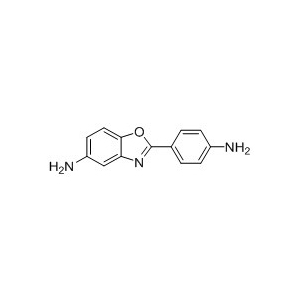Explore Top-Quality APBOA with Aure Chemical
2-(4-Aminophenyl)-5-aminobenzoxazole (APBOA), CAS 13676-47-6, also known as 5-Amino-2-(4-aminophenyl)benzoxazole or DAPBO, is a heteroaromatic diamine monomer featuring a rigid benzoxazole core and dual amine functionalities. This structure imparts high thermal stability, mechanical strength, and chemical resistance to derived polymers like polyimides, making it suitable for advanced materials synthesis.
Basic Information of APBOA
| Product Name | 2-(4-aminophenyl)-5-aminobenzoxazole |
|---|
| Abbreviation | APBOA |
|---|
| CAS Number | 13676-47-6 |
|---|
| Molecular Formula | C13H11N3O |
|---|
| Molecular Weight | 225.25 g/mol |
|---|
| Appearance | Off-white to tan solid |
|---|
| Purity | ≥99% |
|---|
| Package | 1kg/bottle, 20kg/drum, or customized |
|---|
| Molecular formula |  |
|---|
Key Properties
High thermal stability and structural rigidity
Good chemical resistance in harsh environments
Stable mechanical properties when incorporated in polymers
Can contribute to flame retardancy in derived polymers (polyimide may not require additional flame retardant)
Dual amine functionality enables polymer chain extension or crosslinking
Key Applications of APBOA
High-Performance Polymers: Serves as a comonomer for synthesizing polyimides, polyimide copolymer fibers, and closed-cell rigid polyimide foams with enhanced thermal stability, rigidity, and flame retardancy, used in aerospace composites, aviation materials, and high-temperature structural components.
Electronics and Optoelectronics: Utilized in low-dielectric polyimides for telecommunication devices, flexible solar cell substrates (achieving efficiencies up to 16.1%), capacitors, microelectronics, liquid crystal displays, and laser materials.
Advanced Materials: Applied in covalent organic frameworks (COFs), specialty coatings, nanotechnology, and potentially in antimicrobial agents or pharmaceuticals due to reported antifungal, antibacterial, and anti-diabetic properties (e.g., activating protein kinase B for glucose metabolism regulation).
Detailed COA / TDS / MSDS are available upon request. Please Contact Us for more information.

